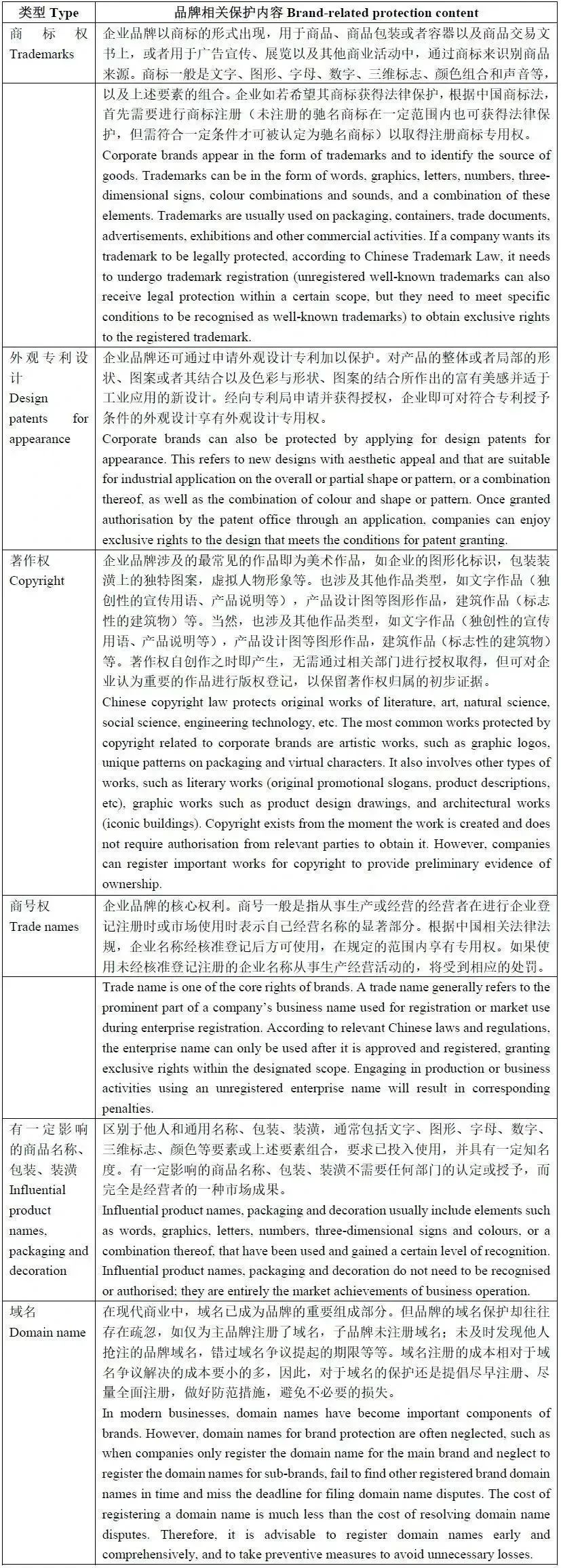企业品牌如何在中国增值——品牌的知识产权变现

作者:刘盈子 刘玉萍 贾青青 王沫
浩天受IAM邀请,成为《世界商标评论》杂志(World Trademark Review,以下简称"WTR")《走进中国IP市场手册》(Inside China’s IP Market: a Guide)专家小组成员。浩天为该项目所撰写的《企业品牌如何在中国增值——品牌的知识产权变现》(How the latest monetisation methods can be used to grow a brand’s value in China),于2023年9月27日首次发表于WTR,欲了解更多分析,请访问WTR与IAM《走进中国IP市场手册》。
Hylands was invited by IAM to be on feature expert panel of Inside China’s IP Market: a Guide. The article How the latest monetisation methods can be used to grow a brand’s value in China for this project was first published on World Trademark Review on 27 September 2023; for further in-depth analysis, please visit WTR and IAM’s Inside China’s IP Market: a Guide.
随着经济发展及市场竞争加剧,品牌作为企业软实力的一项重要内容,不仅承担了最基本的识别作用,通过品牌变现也会为企业带来可观的经济效益。品牌变现,指企业将品牌通过各种方式变价并产生收益,是企业增加核心竞争力、实现创新经营的必然趋势。
With economic development and intensified market competition, brands, as part of a company’s soft power, play an important role in the development of company. They not only serve the basic function of identification but also generate significant economic benefits through monetisation. Brand monetisation is an inevitable trend for companies to enhance their core competitiveness and achieve innovative management.
本文从介绍品牌相关知识产权类型,深入至品牌的知识产权变现渠道。从实用性和操作性角度出发,旨在协助企业了解在中国大陆司法环境下的品牌知识产权变现具体操作方式,提高企业的竞争力和品牌价值。
This article introduces the types of brand-related intellectual property rights in China’s current laws and explores the main ways to monetise a brand under China’s current legal environment. The aim of this article is to help companies monetise their brands with less legal risks, thereby enhancing companies’ competitiveness and brand value.
一、什么是品牌/What is a brand?
在中国现行法律中,并未对“品牌”进行定义。结合司法实践,品牌,一般是指经营者在商业活动中使用的、具有识别功能的各种标记,包括商标、商号、地理标识、有一定影响的商品名称、包装、装潢、域名等。在商业活动中,品牌不仅仅是用于识别之用的标识,还可以唤起消费者对该品牌的文化、该品牌相关商品/服务的质量等的认知。
In China’s current laws and regulations, there is no specific definition of ‘brand’. Based on judicial practices, a brand generally refers to various marks used by business entities in commercial activities for identification purposes, including trademarks, trade names, geographical indications, influential product names, packaging, decoration and domain names. In modern businesses, a brand is not only a means of identification but also tells consumers about the brand’s culture, the quality of related goods and services, and more.
二、品牌涉及主要知识产权类型/Main types of intellectual property rights related to brands.

三、品牌的知识产权变现/Monetizing methods
1.知识产权许可和转让/Intellectual property licensing and transfer of rights
企业结合商业计划,可将品牌相关的知识产权(如商标、著作权、外观设计专利、域名)许可或转让给第三方。通过该种方式,企业可获得许可使用费或者转让金,同时实现商业目的,如子品牌独立,转让品牌给第三方,或者扩大经营等。
In conjunction with business plans, enterprises can license or transfer brand-related intellectual property (such as trademarks, copyrights, design patents and domain names) to third parties. Through this approach, companies can obtain licensing fees or transfer fees while achieving business goals, such as sub-brand independence, transferring brands to third parties and expanding business.
许可人和被许可人应订立许可协议,就许可种类、是否可以再许可、许可地域、许可期限、许可使用费、使用方式等进行约定。转让人和被转让人的合同中,也应对转让的权利内容,转让金等进行明确约定。
The licensor and the licensee should enter into a licensing agreement. The scope of permitted use, the type of licence, whether it can be sublicensed, the duration of the licence, licensing fees, any indemnity and liability issues should be outlined in detail under the licensing agreement. In the transfer agreement between the transferor and the transferee, the scope of transferred rights, transfer fees, the exclusivity and liability issues are essential aspects.
此外,知识产权的转让和许可还需符合中国法律的程序要求。例如,中国商标法要求由受让人向商标局提交转让申请。目前实践并不要求企业必须办理商标许可备案登记,但办理备案登记可以起到对抗第三人的效力,并在维权、配合工商行政主管部门的例行检查等方面提供便利。
Additionally, the transfer and licensing of intellectual property rights must also comply with the procedural requirements of Chinese law. For example, according to Chinese trademark law, the transferee is required to submit a transfer application to the Trademark Office. It’s not a mandatory requirement for companies to register trademark licences, but registration can provide preliminary evidence in combating third-party claims and facilitate rights protection and cooperation with relevant administrative departments.
2.商业特许经营/Commercial franchise
企业所拥有的商标、字号、外观设计专利、具有独特风格的整体营业形象等即可形成市场竞争优势的经营资源,而这种经营资源可以通过商业特许经营将企业知识产权的经济效用最大化。商业特许经营,是指企业将其拥有注册商标、企业标志、专利、专有技术等经营资源,以合同形式许可其他经营者使用,被特许人按照合同约定在统一的经营模式下开展经营。企业通过收取特许经营费用获得经济收益。特许经营和品牌授权的关键区别在于商品或提供的服务是否标准化,是否在统一经营模式下开展经营活动并收取相应的费用,特许人还需要符合法律规定的资质。
The operational resources that can create a competitive advantage in the market, such as registered trademarks, trade names, design patents and distinctive overall business images, can be maximised through commercial franchising to achieve the economic benefits of a company’s intellectual property. Commercial franchising refers to a situation where a company licenses its operational resources (eg, registered trademarks, corporate logos, patents and proprietary technologies) to other entities through contractual agreements, allowing the licensee to operate based on a unified business model as stipulated in the contract. Enterprises can earn economic benefits through franchise fees. According to Chinese current laws and regulations, the key difference between franchising and brand authorisation lies in whether the goods or services provided are standardised, whether business activities are carried out under a unified business model and whether corresponding fees are charged. Franchisors also need to meet the qualifications stipulated by law.
3.品牌的商品化开发/Commercialization of the brand
对品牌的商品化开发,在发达国家较为成熟,在中国还处于发展阶段,但其蕴藏的巨大经济价值不可忽视。所谓“商品化”,是指企业将其与特定品牌相关全部或部分知识产权(含商标、著作权、外观设计等)自行或许可第三方进行开发利用,比如品牌动漫形象的商品化开发、品牌元宇宙虚拟形象的打造等等。通过对品牌的商品化开发,增加品牌的曝光度,增进消费者对品牌的认同感,进而提升品牌以及企业的声誉,达到增加企业的经济收益的效果。
The commercial development of a brand is more common in developed countries, but is still in the developmental stage in China. However, its enormous economic value should not be overlooked. ‘Commercialisation of the brand’ refers to enterprises developing and utilising all or part of the intellectual property (including trademarks, copyright and design patents) related to their brand by the enterprise itself or by licensing to third parties. Examples include the commercial development of branded animation characters and the creation of branded metaverse avatars. By commercialising the brand, consumer identification with the brand is enhanced, and the reputation of both the brand and the company is improved, thereby increasing economic benefits.
4.知识产权作价投资/Contributions by valuated brands
企业品牌作价出资是一种常见的品牌变现方式,是将企业品牌作为资产,投入到另一家企业或项目中,以获取相应的股权或利益,实现品牌变现。品牌作价出资是中国公司法明文规定的一种法定出资方式,知识产权可以100%作为注册资本注资。品牌出资流程较之常见出资流程需要注意的是,出资人需要拥有品牌的所有权,各股东需要认可关于品牌价值的评估报告,品牌所有权需从股东转让给公司,最后办理工商登记。企业品牌作价出资需要综合考虑品牌价值、合作伙伴、风险和收益等因素,同时避免隐形品牌出资。在选择合作伙伴和合作项目时,要进行充分的评估和判断,以确保变现的效果和长期利益的最大化。
Contributions by valuated brands are a common method of brand monetisation, where the brand is invested into another company or project to obtain corresponding equity interests or benefits, thus achieving brand monetisation. Brand capital contribution is a legal capital contribution method stipulated in the Chinese Company Law, and 100% of intellectual property rights (including brands) can be injected as registered capital. In comparison to the common capital contribution process, it should be noted that the investor owns the rights to the brand. Each of shareholders must approve the brand’s valuation report, and the brand’s rights should be transferred from the shareholder to the company. Finally, the business registration must be applied for. Contributions by valuated brand must consider factors such as band value, partners, risks and benefits, while avoiding hidden brand investment. When selecting partners and cooperation projects, it is necessary to conduct full evaluation and judgment to ensure the maximum effect of monetisation and long-term benefits.
5.知识产权质押融资/Brands mortgage financing
企业将品牌中的财产权可作为作为质押物,向金融机构申请贷款,以获取资金。这种方式可以在短期内为企业提供资金支持,同时利用品牌价值实现变现。在2023年1月,国家知识产权局发布数据显示,2022年全年专利商标质押融资总额达4868.8亿元人民币,连续三年保持40%以上增速,惠及企业2.6万家,其中70.5%是中小微企业。通常而言,对知名度越高、营收贡献率越大,商标权质押融资金额就会越高,如2008年,中国山东鲁花集团公司以其驰名商标“鲁花”质押在中国农业银行山东省分行取得了15亿元人民币的银行贷款授信。实践中,品牌权利人先向银行提交品牌质押贷款书面申请,由评估机构对专利权、商标权等进行评估,银行对企业的基本情况等信息进行审核,审核通过后,双方签订借款合同、质押合同,品牌权利人前往知识产权部分办理质押登记手续,双方执行借款合同。需要注意的是,企业品牌质押融资需要综合考虑品牌价值、金融机构、风险和收益等因素。在选择金融机构和确定融资金额时,需要进行充分的评估和判断,以确保变现的效果和还款能力。同时,在质押期间,需要维护品牌的形象和口碑,避免对长期发展产生不利影响。
Companies can apply for loans from financial institutions by pledging their brand’s property rights as collateral to obtain funds. This approach provides short-term financial support for companies and enables monetisation by utilising the brand’s value. In January 2023, data released by the Chinese National Intellectual Property Administration (CNIPA) showed that the total amount of patent and trademark pledge financing reached 486.88 billion yuan in 2022, maintaining a growth rate of over 40% for three consecutive years, benefiting 26,000 enterprises, 70.5% of which were small and medium-sized enterprises. Generally, the higher a brand’s reputation and revenue contribution rate, the higher the financing amount for trademark pledges. For example, in 2008, China’s Shandong Lu Hua Group obtained a RMB1.5 billion bank loan credit from the Agricultural Bank of China Shandong Branch by pledging its well-known trademark ‘Lu Hua’. In practice, the brand owner first submits a written application for brand pledge financing to the bank. An evaluation agency assesses the value of the patent right, trademark right, etc. The bank reviews the enterprise’s basic information and, once approved, the two parties sign a loan and a pledge contract. The brand owner then registers the pledge with CNIPA, and the loan contract can be executed. The brand pledge financing needs to comprehensively consider factors such as brand value, financial institutions, risks and benefits. When selecting a financial institution and determining the amount of financing, it is necessary to fully evaluate and judge to ensure the effectiveness of monetisation and the ability to repay. At the same time, during the pledge period, it is necessary to maintain the reputation of the brand to avoid adverse effects on long-term development.
6.获取维权收入/Seeking compensation through litigation proceedings
诉讼维权的基本目的在于制止侵权行为的发生、消除侵权行为带来的名誉和经济上的损失。对于储备有稳定的、具有一定影响力的品牌的企业而言,提起诉讼并获得赔偿是一种常见的变现渠道。企业发现他人侵犯品牌的合法权益,或存在不正当竞争行为,如虚假宣传、诋毁等,可以提起相关诉讼获得赔偿。如国际知名高端品牌“德禄”在商标侵权及不正当竞争案件中获赔5000万元人民币,知名运动品牌“NEW BALANCE”在商标侵权及不正当竞争案件中获赔2500万人民币。但以诉讼获得赔偿而变现的渠道需要经过法律程序,且存在一定的风险和不确定性。在诉讼前,企业需要充分评估诉讼风险和收益,选择合适的诉讼策略。同时,在诉讼过程中,也需要这种维护自身品牌形象和口碑,避免影响企业的长期发展。
The basic purpose of litigation and rights protection is to stop infringement and eliminate reputational and economic losses caused by infringement. For companies with stable and influential brands, seeking compensation through litigation is a common channel for monetisation. When a company discovers others infringing its legitimate rights related to the brand or engaging in unfair competition, such as false advertising or defamation, it can file relevant lawsuits to seek compensation. For example, the international well-known brand ‘Durex’ was awarded 50 million yuan in trademark infringement and unfair competition cases, and the well-known sports brand ‘NEW BALANCE’ was awarded 25 million yuan in trademark infringement and unfair competition cases. However, monetisation through compensation obtained from lawsuits involves legal procedures and carries certain risks and uncertainties. Before filing a lawsuit, companies need to fully evaluate the risks and benefits of litigation and choose appropriate legal strategies. During the litigation process, it is also important to maintain the brand’s reputation to avoid negative impacts on the long-term development of the enterprise.
四、结语/Conclusion
企业品牌的知识产权管理和变现是一个复杂的系统,涉及商标权、商号权、著作权、专利权、域名等多项权利。今日,中国仍然是全球最具吸引力的投资目的地之一,中国经济的长期向好将为外资企业提供发展机遇和广阔空间。中国政府为促进品牌市场化配置和交易流转提供了优质的法律支持和政策环境,为域外品牌引进提供了丰富渠道,更好助力科技型、创新型的企业发展和整体经济发展。
The management and monetisation of intellectual property rights are complex systems, involving trademark rights, trade name rights, copyright, patents, domain names and other rights. Today, China remains one of the most attractive investment destinations globally, and the long-term positive trend in the Chinese economy will provide development opportunities and broad space for foreign-funded enterprises. The Chinese government has provided high-quality legal support and the policy environment to promote the marketisation and transaction circulation of brands, provided rich channels for the introduction of foreign brands and supported the development of technology-oriented and innovative enterprises as well as overall economic growth.
在此时代背景下,我们希望可以协助企业在中国更加有效地管理和保护品牌的知识产权,实现品牌的知识产权变现,减少品牌被滥用或盗用的风险,维护品牌以及企业的声誉和市场地位。
Against this background, we hope to effectively assist enterprises in managing and protecting their brands’ intellectual property rights in China, achieve monetisation of the brands’ intellectual property, reduce the risk of brand misuse or misappropriation and safeguard the reputation and market position of brands and enterprises.







